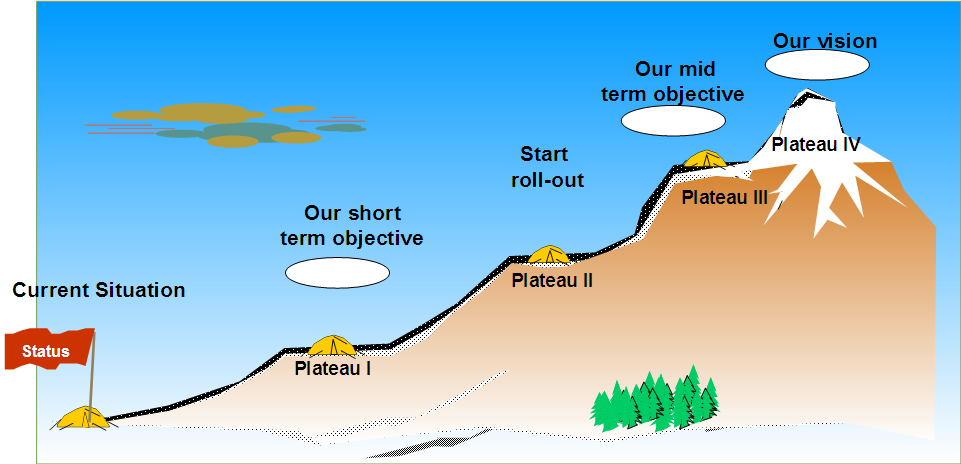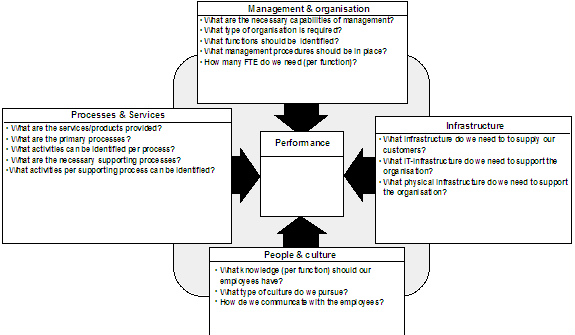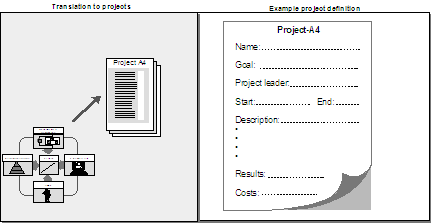BPI Technique - Plateau Planning - PP
Approach





Description
- Plateau Planning is a technique for planning and control of the implementation of integrated BPI programs. It provides a way to separate the implementation plan into manageable segments that co-ordinate changes within the framework of four growth processes: Infrastructure, Management & Organization, Processes & Services and People & Culture.
- Plateau planning is based on the idea that to manage major organizational change, we should manage complexity and risk by proceeding through a number of discrete “plateaus”.
- The Migration Plan describes each plateau and shows how the organization will move from one plateau to the next over the migration period.
When To Use
- The method is useful for planning the implementation of multi-dimensional, integrated organizational changes. With this type of change, management should have a clear picture of a desirable future state (the final goal). This state must be defined in terms of a vision and the four growth processes: Infrastructure, Management & Organization, Processes & Services and People & Culture. However, the road towards the final goal is not yet known. Some sample situations include the following:
- Implementation of the results of a business process redesign project;
- Implementation of strategic policy changes;
- Development of entirely new organizations.
- The growth processes mentioned previously are a key concept. These growth processes are the critical dimensions that together define the organizational development needed. The general idea is that the growth processes must be in balance at any given plateau. Therefore, processes must be balanced with IT, organization & control and people, etc.
- Plateau Planning can be described as a step-wise planning tool. On every plateau, a balanced situation should exist which makes flexible planning possible; plans can be changed at every plateau as shown in the following picture.
Figure 1: Plateau Planning allows for change
- Depending on the focus of the implementation, Plateau Planning can use two different sets of growth processes; the 'IT oriented' processes and the 'business-oriented' processes. Both are described in following paragraphs.
IT oriented growth processes
- The IT oriented growth processes were originally introduced by Richard Nolan in his “stages theory”. This theory postulates that the development of the use of information technology can be seen as a learning process driven by four underlying growth processes.
- Every plateau is in balance, in term of the four growth processes as well as overall performance. BPI projects with a strong IT focus should use the four processes mentioned above.
- Each process can be defined as:
- IT-infrastructure: The resources in terms of IT-personnel, hardware, software, and network which are necessary to utilize the application portfolio;
- Management & organization: The organizational structure, performance measurement, and management principles of an IT organization;
- Users: The employees' premises that need to be fulfilled in order to utilize the application portfolio effectively and efficiently to achieve the organization's goals;
- Application portfolio: The interface between the automated tools and the users, that creates added value in line with the stated goals of the organization.
- The content of the four IT growth processes can be found by answering the questions as shown in figure 2.
Figure 2: What can be the content of the IT growth processes?
- The four IT growth processes should eventually lead to bottom line performance. This is measured in the centre square, where cost, benefits and other performance indicators track the results of the four processes.
Business oriented growth processes
- Transformation projects that are more generally business focused should use the business growth processes. The four business processes were designed by NNC in the 1980s. The processes are shown in the following picture.
- Each process can be defined as:
- Infrastructure: The long term facilitating structure of the organization which consists of agreements, information technology, buildings etc.;
- Management & organization: The organizational structure, performance measurement, and management principles of an organization;
- Processes & services: The processes (primary and support) and services that create value added for the organization;
- People & culture: The perspective of the employees on the organization and their capabilities.
- The content of the four business growth processes can be found by answering the questions as shown in figure 3.
Figure 3: What can be the content of the business growth processes?
- The four business growth processes should eventually lead to bottom line performance. This is measured in the centre square, where cost, benefits and other performance indicators track the results of the four processes. The Balanced Business Scorecard provides a useful framework to develop such performance measures.
- To build a plateau plan the following four major steps are to be taken: Design the individual plateaus, Describe the goals, Plan the first plateau in detail, Secure control of the change in the organization.
- The goal of the first step is to create for every plateau a goal, theme, time frame and responsible person. The goal of the second step is to refine the model as developed in step 1 to detailed results per growth process per plateau and identify the costs and benefits of each plateau. The third step will create a detailed action plan on how to get to the first plateau (and the zero-plateau “ready to start”). Finally step 4 has to make sure that planning is translated into action
- Design the individual plateaus
- Describe the desired goal of each plateau in general terms and assign a time frame. Both should be challenging but realistic.
- Make sure the organization signals change fast by putting big changes in the first plateau
- Introduce the bad news on first plateau
- Start with organizational changes and let technical support follow
- Produce a special theme per plateau. This theme should be a “catchy” phrase, which captures immediately the main issue of that plateau, and is easy to communicate.
- Use themes that describe the major change aspect as seen by the (internal) customer and that inspire a mobilization of the organization
- Assign a manager per plateau, who is responsible for the progress of the activities and communication with all the people involved
- Discuss the names of the potential plateau manager thoroughly in the design teams to create support
- Describe the goals
- Define impact of a theme in refined goals/results for each of the growth processes
- Senior/top management should participate in the workshop
- The growth processes should be balanced to an equilibrium
- Identify the costs and benefits per plateau; one should strive to create a positive cost/benefit relation on every plateau
- To determine cost use experts from client organization
- Revenues can be defined in financial and/or non-financial terms
- The Balanced Business Scorecard can be used for defining revenues. An example is given in figure 4:
Figure 4: Example Plateau Planning results
- Plan the first plateau in detail
- Define projects for the first plateau
- Start by writing down the benefits of a plateau (as defined one step earlier) and identify the projects which are needed to realize these benefits (benefit project management)
- Be aware that projects can cluster activities for more than one growth process
- Define the zero-plateau “ready to start”
- Include a zero-plateau. This plateau indicates (small) changes, arrangements or materials that need to be made before total implementation can start.
Figure 5: Example project A4
- Secure control of the change in the organization
- Assign project leaders to all projects
- The plateau manager (as assigned in Step 1) is responsible for progress and for managing influences from the environment
- Let the newly assigned project leaders check the validity of the plateaus designed in workshops (this will also create commitment
- Make an action plan per project
- After assigning project leaders, plans per project are prepared by the project leaders
- The action plan should consist of activities, starting points, conditions, constraints, etc.
Guidelines
Tactics/Helpful hints
- Let the level of detail of the PBI depend upon the detailed level of the earlier defined vision and design. A detailed description of the desired state of the growth processes is a necessity. If the design is not refined enough when you start the PBI planning, you should refine it during the planning process itself.
- The level of detail in the PBI planning also depends upon the level of sophistication of the organization; if the company is used to implementing change processes a lower level will suffice.
- Using a performance measurement to track the project progress can be highly effective. If the target organization does not (yet) have such a measurement system, we strongly recommend that you develop such a system. The (Balanced Business Scorecard) is a useful technique to identify the applicable performance measures.
- Always try to incorporate the methods and techniques which are already in use by the company itself. This will smoothen the implementation of the organizational change.

No comments :
Post a Comment